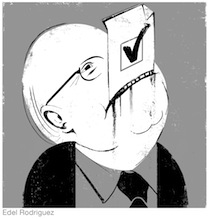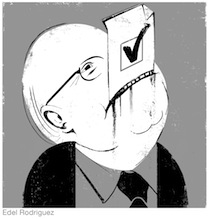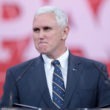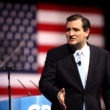 For 30 years, Karl Rove has won elections by a formula that depended on deceit and defamation. A whispering campaign that described Texas Governor Ann Richards as a closet lesbian; an announcement that two aides working for Texas Agriculture Commissioner Jim Hightower would be indicted (before Justice Department lawyers made any announcement about indictments); rumors of John McCain’s illegitimate black child that circulated in South Carolina after McCain defeated George W. Bush in the 2000 New Hampshire primary; rumors about Cindy McCain’s drug habit; a national media campaign that turned John Kerry’s service in Vietnam into a liability.
For 30 years, Karl Rove has won elections by a formula that depended on deceit and defamation. A whispering campaign that described Texas Governor Ann Richards as a closet lesbian; an announcement that two aides working for Texas Agriculture Commissioner Jim Hightower would be indicted (before Justice Department lawyers made any announcement about indictments); rumors of John McCain’s illegitimate black child that circulated in South Carolina after McCain defeated George W. Bush in the 2000 New Hampshire primary; rumors about Cindy McCain’s drug habit; a national media campaign that turned John Kerry’s service in Vietnam into a liability.
Later in his career, Rove’s connections with Republican state officials overseeing elections, and the big private corporations contracted to conduct them, have put him in position to manipulate the vote when he couldn’t deliver it.
For the elected officials targeted by Rove, and for those of us who have documented his work, the word schadenfreude will forever be associated with Fox News’s 2012 election night coverage.
Anyone who missed the moment has probably seen the video that went viral: the divided screen displaying the celebration at Obama’s Chicago headquarters on the left and Chris Wallace calling Ohio for Obama on the right. Then Rove—working as a Fox on-air commentator while directing the largest outside-money PACs in the 2012 election cycle—telling the network co-anchor he was wrong.
Although Wallace was seated behind a console, viewers could see his knees buckling as Rove and the Romney campaign bore down on him. “Karl just got off the phone with somebody else,” Wallace said. “You’ve got more-recent figures?”
Wallace turned the decision over to Rove, who stammered about the Ohio secretary of state’s web page and argued that it was too early to make the call. (The Associated Press and the other networks had already called the election.)
Where Wallace failed, Fox co-anchor Megan Kelly manned up, following her producer’s directions to walk back to the network’s decision desk and confirm what the network had reported.
“I think we should bring Chris Stirewalt or Arnon Mishkin out here to sit next to Karl,” Kelly said after she returned from an off-set conference with Digital News Director Stirewalt and the analysts who had made the call.
Michael Barone, a data-driven conservative, finally sat next to Rove and told him the election was over, even as Rove persisted with confused projections of Republican votes yet to be counted.
“I’m just sayin’ in terms of public perception,” Rove said, “it looks a little odd for us to be making the call.”
Rove’s on-air meltdown was understandable. He had just squandered $300 million that corporate oligarchs poured into the two dark-money PACs he created to buy the Senate and the presidency.
Plaintiff’s attorney Clifford Arnebeck has a different theory.
Exactly seven hours before Rove embarrassed himself and Fox News, Arnebeck was in an Ohio courtroom, arguing that a secret contract the state’s secretary of state had executed with a voting-tabulation company created the capacity to “flip the vote” in 25 Ohio counties.
To understand Arnebeck’s lawsuit, it is necessary to understand who the defendants were.
Jon Husted is a Republican secretary of state who has spent much of the past two years working to restrict early voting, which in previous elections has been used by far more Democratic than Republican voters. (See “Stealing Ohio,” Washington Spectator 9/1/02.) When a law passed in haste by the Republican-dominated Ohio General Assembly created confusion about early voting, Husted issued an advisory opinion that allowed only members of the military to vote on the weekend before the election. He then fired Democratic election commissioners who challenged his ruling. And after a federal district judge held that Ohio’s ban on early voting was unconstitutional, Husted refused to comply with the court’s order, insisting he would not begin preparations for early voting until an appeals court ruled on the case. When the U.S. Sixth Circuit Court of Appeals upheld the lower court decision, Husted appealed the to the U.S. Supreme Court, in an attempt to run out the clock on early voting. Four days before the election, he issued restrictive rules on the counting of provisional ballots.
“The surreptitious manner in which the Secretary went about implementing this last minute change to the election rules casts serious doubt on his protestations of good faith,” federal District Judge Algenon Marbley wrote in a decision handed down after the election.
Arnebeck’s second defendant was Election System & Software, one of the big two voting-technology companies that control 70 percent of elections in a U.S. voting system that is almost completely privatized.
ES&S made national news in 2006 when its tabulation program registered an 18,000 undervote in a South Florida congressional race that Republican Vern Buchanan won by 369 votes—out of 238,000 cast. Most observers, according to the Charlotte Sun, concluded that absent the undervote, the Democratic candidate would have won.
The Port Charlotte, Florida, daily also reported on a New York study that found an ES&S “precinct-based voter counter” that tends to add votes in some elections. The same model counter lost 11,000 presidential votes when it was used in Florida in 2008.
More closely related to the lawsuit that Arnebeck filed in Ohio was a forensic audit of ES&S software in Venango County, Pennsylvania, where two computer science professors from Carnegie Mellon University documented multiple unauthorized remote connections to ES&S tabulation servers. The outside access to the servers was unknown to election officials until the forensic audit was released.
The report was suppressed after ES&S threatened legal action. But the Brad Blog, which does in-depth election coverage, obtained and posted a copy along with a letter from ES&S that charged the Carnegie Mellon professors with unlawful possession of proprietary information.
Arnebeck was skeptical about a contract signed by Husted and ES&S less than two months before the election with no public review or bidding and no testing of the software.
“They are both behaving in a suspicious way,” Arnebeck said in phone interview. “Whether or not they are coordinating, I can’t say. But Husted has been involved in a lot of questionable activities going into the election.”
Arnebeck’s client was Bob Fitrakis, a journalism professor who has used the online Free Press to document election irregularities in 2004 in Ohio. Fitrakis has co-written several books on election theft. He is also a sophisticated political activist. He ran for Congress (as a Green Party candidate) so that he would have standing in election-related lawsuits. He and his co-author, Harvey Wasserman, are persistent critical observers of the election process in Ohio.
Before filing suit, Fitrakis got word that a software contract between Husted and ES&S had been signed within months of November’s election.
Fitrakis submitted an open-records request for the contract, and according to Arnebeck was “stonewalled” by the secretary of state’s office. (At the November 6 hearing, an attorney representing Husted said the secretary of state’s office had been working to pull the requested material together.) Less than a week before the election, a source inside the government quietly provided Fitrakis the 28-page document that was withheld by the secretary of state.
The contract describes “a stand-alone singularly focused” software application that could produce a “precinct-level, candidate, elections result file for all state requested offices.” Arnebeck’s description is not so benign. In court pleadings, he described a plan to install ES&S software “patches” on computers tabulating votes in 25 of Ohio’s counties, including the three most populous counties in the state. The patches had not been tested by an elections board as required by state law because they were designated as “experimental,”thus not subject to the requisite testing. Installing them created a “back door” that could allow outside access to the voter-tabulation system, Arnebeck told the state judge hearing the case.
An attorney representing ES&S wrote in a memorandum filed with the court that the software “does not have the capacity to access or alter a vote in Ohio, even if the imagined saboteur exists.” Arnebeck’s allegations are based on speculation, the attorney wrote (and argued in court).
At the November 6 state court hearing (Arnebeck made a similar argument in federal court the same morning), Arenebeck told the judge that the patches were the point at which the “man-in-the-middle attacks” that Karl Rove had used to flip Ohio’s votes in the 2004 election could be implemented in 2012.
I asked Arnebeck about his “man in the middle” allegation. He said it was supported by the affidavit of Stephen Spoonamore in a lawsuit Arnebeck filed alleging electronic manipulation of election results in 2004.
According to SourceWatch, Spoonamore, a Republican, is a “recognized expert in the field of data security and digital network architecture” who has worked as a consultant for MasterCard, American Express, Chubb Insurance, Bloomberg, and others.
Spoonamore attested that he found evidence that Rove, in collaboration with IT company owner Mike Connell, had used computer fraud to steal the 2004 election for George W. Bush.
The tabulation system Connell designed allowed for the introduction of a third computer “between computer A and computer B,” Spoonamore had written.
“This centralized collection of all incoming tabulations would make it easy for a single operator, or preprogrammed ‘force balancing computer’ to change the results in any way desired by the team controlling Computer C.”
Connell’s IT firm had been employed by the Bush-Cheney campaign, the Republican National Committee, the National Rifle Association, and numerous Republican candidates and elected officials. According to Craig Unger’s recently published book Boss Rove: Inside Karl Rove’s Secret Kingdom of Power, Connell’s firm was “a powerful technological tool” at Rove’s disposal. Connell was also a key witness in the voting-theft lawsuit Arnebeck filed after the 2004 election.
Connell died while returning from a business trip to Washington, when his private plane crashed within miles of the Cleveland airport on December 19, 2008. The circumstances of his death, while Arnebeck was preparing to depose him for a second time, resulted in a series of articles, mostly in progressive news outlets, that attempted to tie Connell’s death to his critical role as a witness.
In Boss Rove, Unger reports that there was no evidence of foul play.
Spoonamore, a witness with unimpeachable IT credentials, believes the 2004 election was stolen in Ohio. “What they did was brilliant,” he told Unger. “You have to admire that. They won. They changed the election. Kerry won but they switched it to Bush. Trust me, that’s what they did.”
The 2004 Ohio election was the backstory to the lawsuit Arnebeck argued on Election Day 2012, which was largely ignored by mainstream media.
No one expected Franklin County Court of Common Pleas Judge Mark Serrott to issue a restraining order postponing a national election. The lawsuit was a preemptive measure. Arnebeck and Fitrakis were creating a public record that documented the existence of potentially malicious software that was secretly put in place by the secretary of state. They would have filed suit earlier, if they had had the contract earlier, Arnebeck said.
Judge Serrott said a court order for a recount paid for by ES&S was premature and denied Arnebeck’s request for relief: “You can always ask for a recount [after the election]; if I draw that case I’m happy to look at it and maybe make a determination of who should pay for it.”
The prospect of a canvass of paper votes created by the electronic system, overseen by a special master selected by the state court, was a hedge against election theft.
On election night, Rove assumed he was betting into the fix. The Fox political analyst had reason to believe that Mitt Romney would carry Ohio, not by a narrow margin at the polls but by the shifting of votes at a computer console, according to Arnebeck.
As it turned out, Obama didn’t even need Ohio to win the election.







0 Comments
Trackbacks/Pingbacks